| |||||||
| Search Forums |
| Advanced Search |
| Go to Page... |
 |
| Search this Thread |  56,432 views |
| | #1 |
| Distinguished - BHPian  Join Date: Feb 2006 Location: NSEW
Posts: 3,768
Thanked: 25,495 Times
| Aircons! Demystifying the car air-conditioning system Introduction Air-conditioning has become integral to the lives of almost all of us, while at home, while at work and while in the car. When the market knows that something like the air-conditioner is indispensable, there is a huge demand for its service, and in most cases, service providers, who are hard pressed for time, carry out quick jobs not in accordance with the right procedure. End result - the end user gets deficient service, spends more than what is required, or both. A car’s A/C typically costs more than an equivalent home conventional split A/C. A sub-optimal car A/C is the one unit that causes immediate discomfort to those inside the car, and rectifying issues can become a recurring expense if not rectified professionally. The next few posts aim at : 1. demystifying the car air conditioning (A/C) system 2. educating readers on some basic troubleshooting and fixes plus DOs and DONTs on the car A/C 3. illustrating how a car’s A/C system can be maintained and serviced the easy way Acknowledgement My benchmarks for excellence in long term reliable performing car air-conditioners have been 1. My 2005 Toyota Corolla which is now with another owner – 16 years and 1,20,000kms and still on the original A/C. Only the cabin air filter was changed from time to time 2. A 1997 Honda Accord with someone close in New York that went on for 2,00,000 miles and 20 years with the A/C never touched 3. My 2003 Maruti Versa that I used for close to seven years and on which I didn't spend a penny on the A/C 4. My 2007 Suzuki Grand Vitara, still on its original evaporator after 14 years Whatever I’m sharing wouldn’t have been possible if I hadn’t observed several A/C workshops over 23 years – Sunderlal, Ravi and Sijumon in Surat (Gujarat), Billu and Kedar’s in Vadodara (Gujarat), Prakash Jana in Chennai, and Prajeesh of AIRCON Car A/C Tiruchirapalli (TN). Some could have done work better, but all of them have been very helpful and well meaning people. From whatever I've read, seen, and experienced, Prajeesh’s workshop adopted the best practices of car A/C service that I have seen this far in my automotive journey. Last edited by vigsom : 12th May 2021 at 22:02. |
| |  (71)
Thanks (71)
Thanks
 |
| The following 71 BHPians Thank vigsom for this useful post: | aaggoswami, Abhi_abarth, Akshay6988, AlphaPetrolhead, ankurj, ashking101, Avikbrio, bikertillidie, brownkaiser, CEF_Beasts, chiranjitp, classiccurves, CptSlow, denzdm, discoverwild, Dr.AD, DrANTO, drift87, DriverNo.420, echo77, espraveen, GTO, haisaikat, iamitp, IamNikhil, InControl, IndigoXLGrandDi, jithin23, kap04, KPR, KuvamBansal, landcruiser123, lapis_lazuli, lemedico, Mr.Boss, MSAneesh, museycal, Nature&Me, Nitish B Shetty, oakajale, PaddleShifter, papr23, paragsachania, PM - B, procrj, Prowler, raghuram.cg, Ragul, Ranger747, Reinhard, Researcher, Rigid Rotor, romil.shroff, Rshreyansh, s10, sridhar-v, streetfighter, StrikerK, Sudarshan_N, sukhbirST, superguy282, Suraj, Tgo, theexperthand, Turbojc, V.Narayan, vaasu, vishy76, vredesbyrd, whitewing, ysjoy |
| |
| | #2 |
| Distinguished - BHPian  Join Date: Feb 2006 Location: NSEW
Posts: 3,768
Thanked: 25,495 Times
| re: Aircons! Demystifying the car air-conditioning system Basic Components of a car air conditioning system The following short video provides a quick overview of the components of a car air-conditioning system (please ignore the pressure ranges mentioned in the video – the low pressure side would be a typical 25-40 psig while the high pressure side would typically read 150-200 psig) Quick recap 1. The compressor compresses R-134a refrigerant (or gas as it is commonly called) to typically 150-200psig 2. Compressed gas flows to an air-cooled condenser, located in the front of the car, right behind the bumper. A fan located either in front of the condenser or behind the radiator ensures that adequate air is pushed through OR pulled through the condenser so that the compressed gas turns into liquid 3. Liquid refrigerant flows through a Receiver Drier (which in older cars was a can type device fitted onto the condenser, while in most cars these days, it is a tubular part integrated with the condenser). The receiver dryer is essentially a moisture trap to trap moisture when the system receives fresh refrigerant after service OR during a top up. It also holds some refrigerant which is used based on a sudden demand, like when the system is started up 4. The liquid refrigerant at high pressure (200 psig) undergoes sudden flashing to a lower pressure (40 psig) at the expansion valve. This reduction in pressure also brings the refrigerant temperature to a typical 5 degrees.C 5. Cold liquid-vapour mix moves through the evaporator (Evap core or Cooling coil in normal parlance). Air, circulated by the blower through the evaporator gets cold while the refrigerant picks up heat from the cabin. The evaporator has a thermistor fitted to it – this measures the evaporator core temperature and sends inputs to the control modules that control the cycle on and off (engage - disengage) of the compressor 6. Vapour refrigerant from the evaporator moves back to the compressor suction at a typical pressure of 25-40 psig. Schematic of a Car Air-conditioner (image courtesy yourmechanic.com)  The compressor needs to have a pre-determined quantity of lubricating oil (typically a PAG oil) to ensure that the compressor doesn’t run dry. Compressor 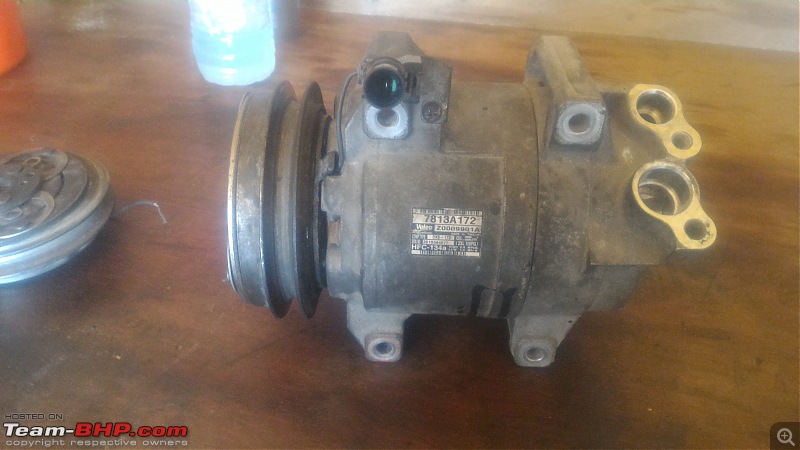 Receiver Drier and Pressure switch( the large condenser can be seen behind the fan)  Expansion valve  Evaporator (Cooling Coil)  Air Blower  Typical low side pressure reading with compressor in operation 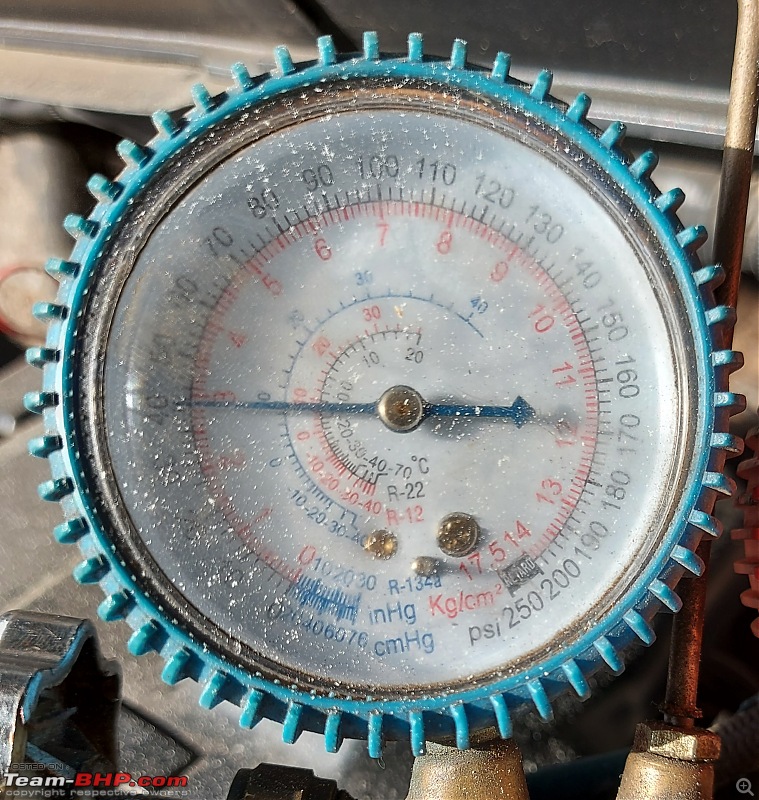 Last edited by vigsom : 12th May 2021 at 21:39. |
| |  (42)
Thanks (42)
Thanks
 |
| The following 42 BHPians Thank vigsom for this useful post: | aaggoswami, anra, ashking101, Avikbrio, CEF_Beasts, CptSlow, digitalnirvana, discoverwild, doxinboy, DrANTO, drift87, DriverNo.420, echo77, espraveen, Gaboonviper04, gopaneel, GTO, haisaikat, Lobogris, Mr.Boss, MSAneesh, Navsangeet, PaddleShifter, paragsachania, procrj, Prowler, Reinhard, Researcher, Rigid Rotor, Rshreyansh, SanSabh, sdg4wheels, sohanbala, Tgo, tharian, Turbojc, V.Narayan, vaasu, WhiteSierra, yesyeswe, yogiii, ysjoy |
| | #3 |
| Distinguished - BHPian  Join Date: Feb 2006 Location: NSEW
Posts: 3,768
Thanked: 25,495 Times
| re: Aircons! Demystifying the car air-conditioning system Air-conditioning controls Basic controls on a manual Air conditioning system The most basic inputs and controls on a car A/C are 1. a blower control switch with typically 3 or 4 speed settings 2. a thermistor which senses the temperature on the evaporator body and provides an input to engage or disengage the compressor 3. a flap control knob to control the direction of air flow – to defrost the windscreen, to direct air straight out of the dashboard vents, or to direct towards front occupants feet and face 4. a temperature control knob which is essentially a flap controller – this keeps the heater side flap closed when the knob is in the extreme low on the blue band, and then gradually opens the flap towards the heater coil as the knob is turned towards the red band. 5. a manual control lever OR a button operating a motor to move a flap to switch between fresh air and re-circulating air Manual AC Control panel of the Maruti Swift (image courtesy boodmo.com) 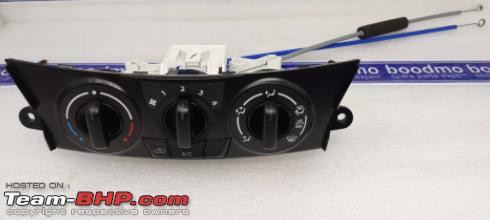 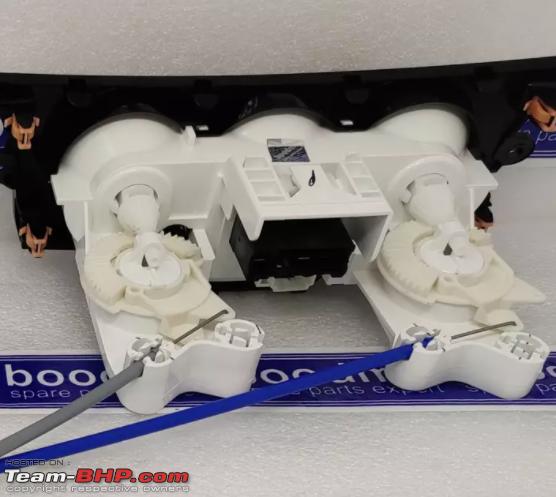 Automatic Climate Control (ACC or FATC) This system has the following to ensure near precise temperature control in the cabin 1. Ambient (or outside air temperature sensor) 2. Cabin air temperature sensor 3. Thermistor which senses the temperature on the evaporator body and provides an input to engage or disengage the compressor 4. Variable temperature setting knob or buttons – to set the cabin temperature at anywhere between 18 and 30 deg.C with steps of 0.5 to 1.0 deg.C 5. Flap control buttons (hard or soft touch) to control direction of air flow as described in basic controls In the case of ACC, the Air-conditioner control module receives inputs from the selector knobs, and accordingly modulates motor controlled flaps to control direction of air flow and to switch between fresh air and recirculating air, and to mix hot and cold air as needed. Unlike in the manual case, the blower can operate at varying speeds. In both ACC and manual modes, the engine coolant temperature sensor overrides the air conditioning system and shuts the compressor off in case the temperature reaches a preset high value (typically 80% of full range) A brief on how a thermistor works can be seen from 00:33 to 1:34 in the attached video Climate Control modules of the 2003-08 Corolla 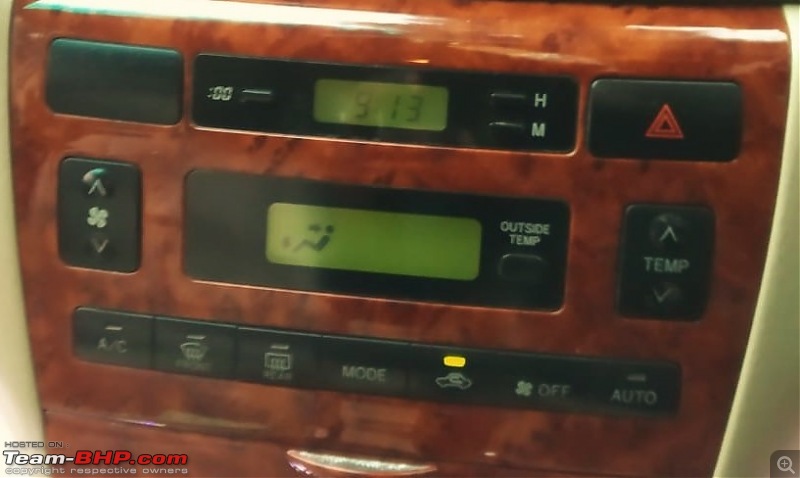 Grand Vitara  Fourth gen Honda City  Last edited by vigsom : 12th May 2021 at 20:26. |
| |  (36)
Thanks (36)
Thanks
 |
| The following 36 BHPians Thank vigsom for this useful post: | aaggoswami, anra, ashking101, Avikbrio, CEF_Beasts, chiranjitp, denzdm, DrANTO, drift87, DriverNo.420, echo77, espraveen, Gaboonviper04, gischethans, GTO, g_sanjib, jithin23, MSAneesh, Navsangeet, Osteon206, PaddleShifter, paragsachania, PM - B, procrj, Reinhard, Researcher, Rigid Rotor, Rshreyansh, streetfighter, V.Narayan, vishy76, vnabhi, vredesbyrd, yesyeswe, yogiii, ysjoy |
| | #4 |
| Distinguished - BHPian  Join Date: Feb 2006 Location: NSEW
Posts: 3,768
Thanked: 25,495 Times
| re: Aircons! Demystifying the car air-conditioning system Compressors Fixed displacement piston type The most common piston type compressors have five pistons that compress the refrigerant vapour. The accessories on the compressor include an electromagnet, a clutch disc and an idler pulley. The electromagnet, when fed with supply voltage engages the compressor clutch disc with the pulley and the compressor starts operating. Cut the supply to the electromagnet off and the clutch disc disengages but the idler pulley keeps running. This cycle of supply on and supply off helps engage and disengage the compressor with the compressor idler pulley. The ECU cuts off power supply to the electromagnet in any one of the following conditions: 1. Evaporator skin temperature reaches the thermistor set point 2. Engine coolant temperature high 3. Refrigerant pressure too low or too high While 1 is a normal variable, 2 is a safeguard built in to prevent engine overheating while 3 is a safeguard to protect the compressor from damage by very low pressure and the refrigeration system from damage due to high pressure The compressor clutch again engages when the value of point #1 falls back to normal range. Operation of the compressor clutch can be viewed in the following video shot on bhpian @aaggoswami's Toyota Innova. Note the compressor right at the top next to the engine coolant reservoir Compressor Clutch Assembly - clutch disc, compressor pulley, and an electromagnet 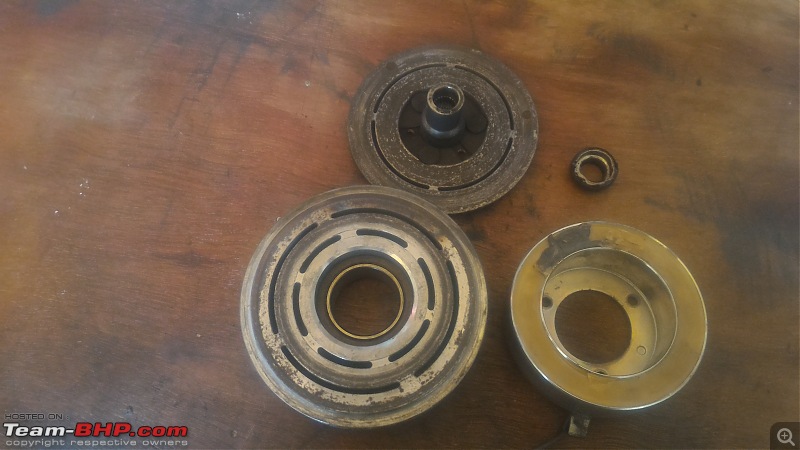 Drawing of the compressor and clutch assembly   Typical operation of a piston type compressor is illustrated in the following video. Note the angled swash plate that converts the rotary motion of the compressor shaft into axial motion of the pistons There are also scroll compressors like those found on the 2003-08 Toyota Corollas; very efficient units but not very common. Last edited by vigsom : 12th May 2021 at 21:50. |
| |  (39)
Thanks (39)
Thanks
 |
| The following 39 BHPians Thank vigsom for this useful post: | aaggoswami, abhi9044, amit_purohit20, anra, ashking101, Avikbrio, CEF_Beasts, chiranjitp, denzdm, DrANTO, drift87, DriverNo.420, echo77, espraveen, FlashMustang, gischethans, GTO, JayKis, jithin23, Mr.Boss, myavu, Navsangeet, PaddleShifter, paragsachania, PearlJam, pjbiju, PM - B, pratika, Reinhard, Researcher, Rigid Rotor, Rshreyansh, Sran, Tgo, vaasu, vredesbyrd, yesyeswe, yogiii, ysjoy |
| | #5 |
| Distinguished - BHPian  Join Date: Feb 2006 Location: NSEW
Posts: 3,768
Thanked: 25,495 Times
| re: Aircons! Demystifying the car air-conditioning system Compressors (Contd.) Variable displacement piston type These are generally direct drive clutchless compressors viz. they remain on all the time, but the loading of the pistons is controlled by an External Control Valve (ECV) which varies the amount of gas compressed based on the refrigeration need. This type of compressor is found on the new gen Hyundais viz. i20 Elite, Creta, Elantra etc. While this type ensures that the engine just takes the required load based on refrigeration demand, the flipside is that the control valve is a potential failure point.The compressor too, can fail if refrigerant and oil leak out of the system. The most common failure here is of the ECV, which itself costs INR 2K to 20k for the part alone. Direct drive clutchless variable displacement compressor  Compressor ECV 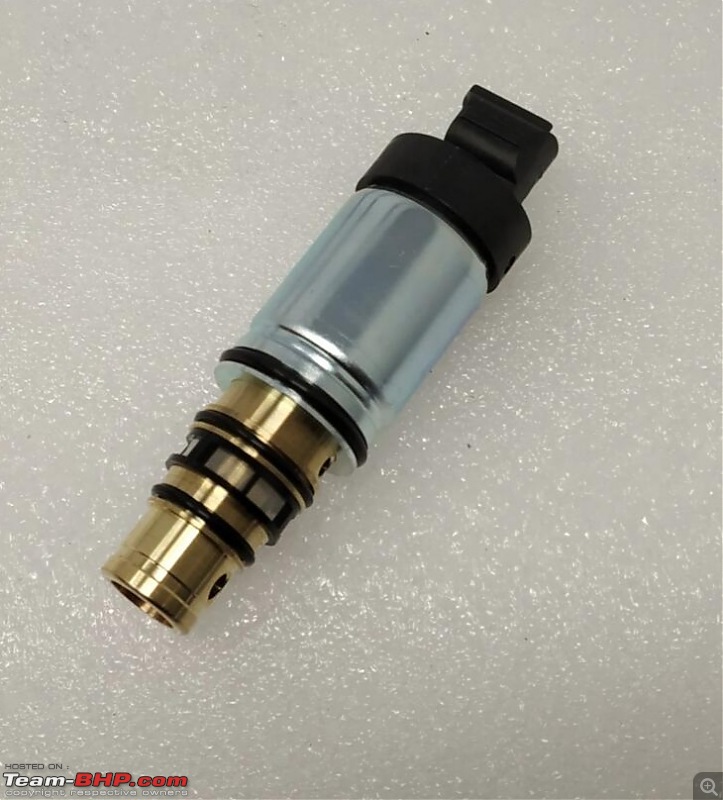 Fixed vs Variable displacement compressors Some other variable displacement type compressors have the electromagnetic clutch system too to cut the compressor off if the system pressure is high or low. Animation of a variable displacement compressor with an electromagnetic clutch in operation Last edited by vigsom : 12th May 2021 at 19:19. |
| |  (34)
Thanks (34)
Thanks
 |
| The following 34 BHPians Thank vigsom for this useful post: | aaggoswami, aeroamit, anra, ashking101, Avikbrio, CEF_Beasts, chiranjitp, denzdm, discoverwild, DriverNo.420, echo77, espraveen, GTO, Herschey, Mr.Boss, Navsangeet, Nitish B Shetty, PaddleShifter, paragsachania, PearlJam, pjbiju, PM - B, procrj, Prowler, Reinhard, Researcher, Rigid Rotor, Rshreyansh, Sanidhya mukund, Sran, Taha Mir, vaasu, yesyeswe, yogiii |
| | #6 |
| Distinguished - BHPian  Join Date: Feb 2006 Location: NSEW
Posts: 3,768
Thanked: 25,495 Times
| re: Aircons! Demystifying the car air-conditioning system Basic DOs and DONTs on a car air conditioning system These tips are the basic minimum that one must do to ensure seamless operation of the air-conditioning system for many years. DOs 1. Keep the inside of the car clean always. 2. If your car doesn’t come with a cabin air filter , install one as soon as possible. It will ensure that the evaporator is clean and doesn’t end up going for premature service 3. Clean the cabin air filter maybe once in 3 months to get rid of leaves, twigs, moths and maybe rat droppings that may have come in over time via the fresh air path. While removing the cabin air filter for cleaning, ensure that the fresh air flap is closed else debris would find its way to the blower and eventually to the evaporator 4. Keep the AC condenser clean at all times. Get it cleaned using a low pressure water spray every 3 months or so 5. Operate the air conditioner at a low blower speed (typically 1 or 2 for a manual AC) OR set the temperature to just the desired level in case you have an ACC. This is to keep the compressor on for optimum time, and thus prolong its life 6. Ensure that the coolant level and quality is tops 7. Ensure that the radiator and condenser fans are in good working order 8. Replace the cabin air filter as recommended in the owner manual I operate my AC sparingly and use a very low blower speed once the cabin cools down. This helps keep compressor operation as low as possible and aids in fuel efficiency too DONTs 1. Don’t run the air conditioner at very low temperature settings. It spoils one’s endurance levels, makes one become a prey to unnecessary comfort, and spoils one’s health too 2. Don’t fall for service centers’ scams stating that the AC isn’t cooling adequately or that the AC needs to be serviced. Once you disturb the factory set up of the Air conditioning system, it will seldom work the same again for as long as the factory set up worked. Again, old performance is possible if commissioning procedures for the system after service are scrupulously followed in accordance with the service manual, but I know that it is seldom followed. Basic troubleshooting of a car air-conditioning system Presented below are some symptoms of poor air-conditioning and some corrective actions. These are just guidelines and diagnosis could differ case to case. If the compressor doesn't turn on when the AC is switched on, one of the three following conditions is the culprit OR the electromagnet is weak or not getting power supply - check the compressor relay in this case. 1. Evaporator skin temperature reaches the thermistor set point 2. Engine coolant temperature high 3. Refrigerant pressure too low or too high Other troubleshooting points are summarized below. Car AC troubleshooting guide  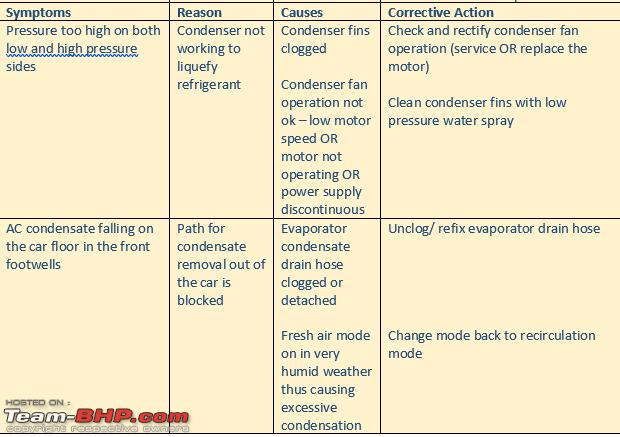 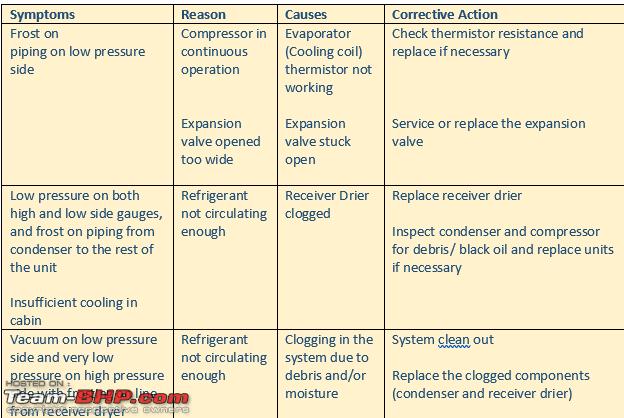 Needless to mention, replacement of any component inside the refrigerant path will need the refrigerant to be removed, and then recharged after the job is over. Last edited by vigsom : 12th May 2021 at 22:12. |
| |  (38)
Thanks (38)
Thanks
 |
| The following 38 BHPians Thank vigsom for this useful post: | aaggoswami, aeroamit, amit_purohit20, anra, ashking101, Avikbrio, brownkaiser, chiranjitp, discoverwild, DrANTO, drift87, DriverNo.420, echo77, espraveen, fluidicjoy, govigov, GTO, kotirajendra, MSAneesh, Navsangeet, PaddleShifter, paragsachania, pjbiju, PM - B, pmrp4mail, pratika, procrj, Reinhard, Researcher, Rigid Rotor, Rshreyansh, Sanidhya mukund, Shome, vaasu, vishy76, Wanderers, WhiteSierra, yesyeswe |
| | #7 |
| Distinguished - BHPian  Join Date: Feb 2006 Location: NSEW
Posts: 3,768
Thanked: 25,495 Times
| re: Aircons! Demystifying the car air-conditioning system Inspection and service of a car air-conditioner Have we seen Carrier window air-conditioners ever requiring attention other than basic cleaning of the filter? No. Same story for the old Fedders Lloyd, Blue Star, and for yester-year refrigerators. On similar lines, a car’s air-conditioner kept clean, used well and built with durable components will never require to be opened for service/ inspection. The reality today is just the opposite – evaporators (cooling coils) leak in 4-6 years, components like the compressor clutch electromagnet and the ECVs fail. Such issues require the air-conditioning system to be opened and “serviced”, and here is where the trouble starts. Very rarely does a “serviced” car AC get back to stock performance. In the event of the car AC requiring unscheduled maintenance due to breakdown OR a scheduled service since the system has gradually lost refrigerant, here are a few points to be followed when the AC is being renewed 1. Most car air-conditioning units require the dashboard to be removed. Here I strongly advocate removing the dashboard whole by removing the steering column, decoupling the several couplers and removing nuts holding the main metal beam to the car frame. Yes, two people are needed to remove the unit out of the car, but the big benefit of this method is - delicate plastics, many bolts and nuts, AC vents and ducts, are intact and the stock fitment is not disturbed Illustration - a 2011 Hyundai i20's dashboard removed as one unit Steering column lowered  Dashboard assembly with the BCM and HVAC Unit removed as one unit 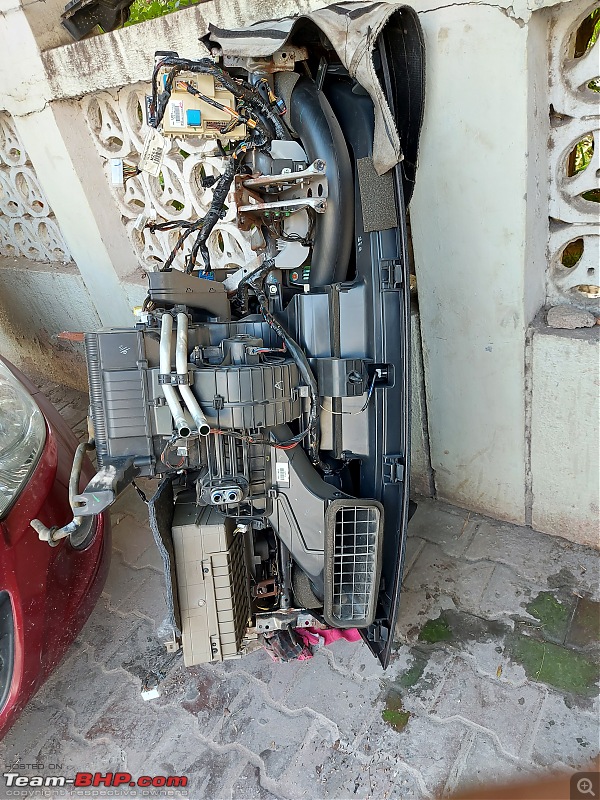 Fouled up and leaking evaporator (cooling coil)  New evaporator installed  While fitting back the dashboard assembly, one had to just align the main beam bolts against the respective holes, and align the refrigerant and heater core lines against the respective openings in the firewall, and then it was good to go. 2. Most A/C technicians perform a leak test of the AC system at 350 psig. This is unnecessary. A pressure of approx. 200 psig is more than adequate.Very high pressure, especially on older systems might damage something else, like how the pressure switch in my 2003 Toyota Corolla leaked during a leak test 3. Most A/C technicians use air for leak test. This will allow some moisture in and although vacuum pulling (evacuation) would remove most of it, some of it would escape into the receiver drier. I'd strongly recommend nitrogen for leak test. If nitrogen is unavailable, next best is dry air from a drier. The odds are that this arrangement is seldom found at A/C workshops. Nitrogen being used for leak test at AIRCON Car AC at Tiruchirapalli (TN)  4. Insist on a minimum 30 minute vacuum pulling (evacuation) even after full vacuum (the lowest reading on the gauge is reached). This helps remove all the moisture out of the system Evacuation on a Tata Nano AC system - this was done for 45 minutes even after full vacuum was achieved 5. Check if the system vacuum holds for a period of at least 10 minutes 6. If the compressor hasn’t been attended to during maintenance, it is assumed that the oil inside is intact. In such a case, approx. 20cc of refrigerant oil is to be added after the vacuum hold test, and before charging refrigerant. This is just to compensate for some oil that might have escaped when refrigerant was removed 7. Ensure that the air trapped in the refrigerant charging hose is purged out before charging refrigerant back into the system 8. Ensure that the recommended refrigerant quantity is added back. This information is available in the owner manual/ on the underside of the hood of the car. A can of refrigerant (Floron, Mafron, Value, Chemours) is 450g, and while even this quantity would provide some “exciting” cooling in the cabin, don’t accept just one can if the car actually needs more Insist that the recommended quantity of refrigerant is added (eg. If a car requires 550 plus or minus 20g, it must get at least 530g in). Best way to determine if the refrigerant charge is good is to feel the compressor low pressure line near the firewall for a serve chilled feeling (also known as sweating). The gauges might look fine but sweating is the key. I hope you enjoyed the lessons !!  Last edited by vigsom : 12th May 2021 at 21:58. |
| |  (97)
Thanks (97)
Thanks
 |
| The following 97 BHPians Thank vigsom for this useful post: | 2TR-FE, aaggoswami, abhi9044, Abhi_abarth, aeroamit, AMG1, amit_purohit20, anantpoddar, anra, ashking101, ashpalio, Avikbrio, bhavukjain, bikertillidie, brohanv, brownkaiser, catchjyoti, CEF_Beasts, chiranjitp, discoverwild, DrANTO, drift87, DriverNo.420, DriverR, DrZhivago, echo77, espraveen, Fiestaboy, fluidicjoy, Gannu_1, goandude, govigov, GTO, Herschey, highway_star, iamitp, ike, InControl, JayKis, jithin23, Kosfactor, lejhoom, lemedico, Leoshashi, luvurride, MithunSathianat, Mr.Boss, MSAneesh, myavu, NagaBond, Nature&Me, Navsangeet, Osteon206, PaddleShifter, padmrajravi, papr23, paragsachania, PearlJam, PGA, pixantz, pjbiju, PM - B, pmrp4mail, Potenza, Prakritij, pratika, procrj, ransomware, Ravi Parwan, RavisankarSD, Reinhard, Researcher, Rigid Rotor, Rshreyansh, saisailendra, Sanidhya mukund, shashanka, Siva Prakash, SlowRider, SnakemanJohny, soulfuel, SPIKE ARRESTOR, Sran, sukhbirST, Tgo, urbanzameendar, Utham123, uyscuti, V.Narayan, VALLURIS, vishy76, vmathews, vnabhi, Wanderers, wheelguy, WhiteSierra, yesyeswe |
| | #8 |
| Team-BHP Support  | re: Aircons! Demystifying the car air-conditioning system Thread moved out from the Assembly Line. Thanks for sharing! |
| |  (4)
Thanks (4)
Thanks
 |
| The following 4 BHPians Thank Aditya for this useful post: | GTO, Herschey, Researcher, Sanidhya mukund |
| | #9 |
| BHPian Join Date: Jan 2020 Location: Tokyo/Ahmedabad
Posts: 121
Thanked: 643 Times
| Re: Aircons! Demystifying the car air-conditioning system Very informative. Thanks for sharing such a detailed thread on aircons. |
| |  ()
Thanks ()
Thanks
 |
| | #10 |
| Distinguished - BHPian  | Re: Aircons! Demystifying the car air-conditioning system Thanks for an excellent and very informative thread. I would like to add a few things. These days most AC car work on R134 refrigerator gas (there are actually a few variations as well). But until 1993 most AC on cars used Freon R12 as it was commonly known. By the early 90’s most countries had made it illegal to use these kind of refrigerants, be it in an AC or your home refrigerator. These older AC system can’t just run on R134 but must be modified. These modifications tend to be quite expensive. These days there is also R437A. It has near identical properties as R134 as far as cooling is concerned. The main difference, it can be used on the old R134 systems without the need for any modifications. Which is great news for the likes such as me, who tend to own old and classic cars. Especially on classic cars, owner often are very particularly about retaining originality and at least with R437, other that the refrigerant, everything else remains as per the original design. When it comes to AC compressors there are actually five different kind of compressors used in the automotive industry. 1 Reciprocating (both the fixed and variable version you mentioned are reciprocating compressors 2 Scroll compressors (probably the latest trend) 3 Screw compressors 4 Rotary compressors 5 Centrifugal compressors (only applicable to fairly large AC systems Personally, but I am no expert, I think the variable reciprocating compressor is most used on modern cars. One of the advantages of the variable version is that it makes for more precise cooling, but it also is more efficient in terms of power it uses. As a rule of thumb: your average AC compressor requires 3-5 horsepower when fully loaded. So on my Jaguar with 400 HP on tap, it is not noticeable. But on smaller cars, with small engine running the AC will show up in your fuel efficiency. Modern cars ECU will also turn of AC in case of high power demands. (e.g. when you floor the accelerator, it momentarily cuts out the AC) and a whole host of other cool features. When it comes to the control of the AC and the various sensors, many upmarket cars with ACC will also have a solar radiation sensor. It is usually easy to spot on the dashboard, it looks like a little plastic dome about the size of dime. It measure the amount of sun radiation, which is a very important part of how quickly the cabin will warm up. When it comes to AC maintenance: I honestly don’t know how the big dealer garages in India work. But I would imagine they use machines like this: These machines are extremely effective and do the whole job fully automatic. So they will extract the old refrigerant and will dispose of it safely. They will vacuum draw and test the system with high quality nitrogen, they will fill the system automatically with the appropriate volume of refrigerant, they will add the correct amount of oil and a Fluorescent dye for UV leak detection. In the west every workshop will have one of these machines, one shape format or the other. It is also partly driven by environmental concerns and legislation. These system are safe and ensure no refrigerant used or new escapes into the atmosphere. Depending on the size of the system the machine would take 30-90 minutes. it does it’s job completely unsupervised. So cars that come in for various maintenance jobs, usually get hooked up to the machine. The technician will just connect the two hoses and start the machine. He/she can just continue to work on other jobs, whilst this piece of kit does its job. I had my 1986 Alfa Romeo Spider AC system refilled with R437 some time ago: https://www.team-bhp.com/forum/diy-d...ml#post4181626 Jeroen |
| |  (36)
Thanks (36)
Thanks
 |
| The following 36 BHPians Thank Jeroen for this useful post: | aeroamit, ashking101, ashpalio, Avikbrio, bhavukjain, bikertillidie, brownkaiser, catchjyoti, drift87, DriverNo.420, Eddy, goandude, Herschey, iamitp, IamNikhil, jithin23, lejhoom, luvurride, Nature&Me, Nitish B Shetty, paragsachania, PM - B, pmbabu, Prowler, RavisankarSD, Reinhard, Researcher, Rigid Rotor, Rshreyansh, saisailendra, SS-Traveller, Tgo, vigsom, vishy76, vnabhi, yesyeswe |
| | #11 |
| Distinguished - BHPian  | Re: Aircons! Demystifying the car air-conditioning system Fantastic thread! So much information, so many pictures - and so easy to understand. You've really compiled a lot of information in a superb way. Rating the thread well deserved 5 stars. A lot of effort put into each aspect of this thread & its showing. Thanks so much for sharing. Its informative threads like these that are the most enjoyable - and unique to TBHP. Stay safe. |
| |  (7)
Thanks (7)
Thanks
 |
| The following 7 BHPians Thank Reinhard for this useful post: | espraveen, goandude, Nitish B Shetty, Researcher, Rshreyansh, vigsom, yesyeswe |
| |
| | #12 |
| Distinguished - BHPian  Join Date: May 2010 Location: Bengaluru
Posts: 4,213
Thanked: 5,881 Times
| Re: Aircons! Demystifying the car air-conditioning system Fantastic thread Vigsom. Well explained ! I will add my 2 cents 1. Inspect the Cabin Air Filter/AC filter every 3 months. The AC filter comes in two types - Mesh type and Folded Paper type. The mesh filter can be cleaned by soaking the filter in soap water and cleaning with a soft brush. If it is the folded paper filter and is dirty, replace it. The AC filter is the best insurance for the entire cooling system. The filter ensures that the evaporator coil behind the dashboard remains clean. If the filter is not present ,the dust accumulates on the evaporator coil and is exposed to the moisture condensation. The combination of dust and moisture will corrode the coil over a period of time and eventfully the coil develops a leak. A clogged filter will also reduce the air flow out of the vents. The filters are cheap and typically last an year if you drive in relatively clean conditions. 2. Cleaning the condenser - The condenser is the part where the compressed refrigerant is cooled. The refrigerant is very hot once it exits the compressor. The condenser is also the first component behind the bumper and is exposed to dust, grime, grease, bugs etc which collect between the fins of the condenser and clog them. This impairs the air hitting the condenser and thereby reduces the heat-exchange and the subsequent cooling of the refrigerant. This reduces the cooling. Whenever the car is washed, clean the condenser as well. Spray some soap water over the fins, let it sit for a minute or two and rinse with a jet of water. If using pressure washer ensure the spray is wide and the nozzle is a foot away from the condenser. Taking care of the above two will ensure the AC chills well and lasts long without giving problems. Most people who complain of low cooling directly think about low refrigerant or leak in the system. But the above two must be the first step of diagnosis in troubleshooting the insufficient AC cooling. I have come across 4 cars whose low cooling issue was resolved just by cleaning the condenser and replacing the AC filter. Not to mention, these two steps can be done at home with basic tools. Last edited by sagarpadaki : 13th May 2021 at 12:04. |
| |  (9)
Thanks (9)
Thanks
 |
| The following 9 BHPians Thank sagarpadaki for this useful post: | aeroamit, chaitanyapramod, espraveen, gischethans, iamitp, Nature&Me, PM - B, saisailendra, vigsom |
| | #13 | ||||
| Senior - BHPian | Re: Aircons! Demystifying the car air-conditioning system Quote:
I find it very disconcerting to see people sit in the car, turn the ignition on, with the blower starting at full blast, the audio system booting up, lights on and then they crank they engine which, shuts all the electricals off momentarily and sending life back to them once the engine is on and idling. Quote:
Quote:
On the flip side, I doubt the guys working on the systems now a days, know the importance of keeping keeping the factory provided tubing joints healthy. Things like keeping them dirt free, keeping the ferrules and the internals intact, checking the o-rings for cracks, aligning the two halves properly before joining the unions and not over tightening o-ringed joints. Which gives us the apprehension of not getting the factory system disturbed. Quote:
On our Duster the AC had the direction knob stuck which is a characteristic issue with manual AC equipped dusters. The ASC guys were over enthusiastic and they said since the dashboard will be opened, we will check the evaporator too. Don't know what they dis but, they did charge us for refilling of the AC gas stating that it gets leaked when we remove the dashboard. 3 weeks later, the compressor died. I was pretty sure that the clutch or the electromagnetic coil would be the culprit. Renault doesn't sell it separately. And since it was soon after the service I decided to send it back to the ASC so that they deal with their wrong doings without blaming any outside intervention. Finally had to shell out 30K for a new compressor as they said it had seized. I guess someone missed topping up the oil. The newer compressor does work better than the older one - I wonder why? | ||||
| |  (4)
Thanks (4)
Thanks
 |
| The following 4 BHPians Thank Tgo for this useful post: | ashking101, InControl, Rigid Rotor, vigsom |
| | #14 |
| BHPian | Re: Aircons! Demystifying the car air-conditioning system Thanks for the extremely detailed write up. It covers pretty much all aspects. Most ac repair shops in India try to advocate replacement of expensive components rather than investigate the root cause/service components religiously. Hence, I often undertake repairs myself. On more than one occasion, issues were caused by faulty thermistors / coolant temperature sensors/ disintegrated thermostat housing. A dual manifold gauge helps a lot during initial troubleshooting. Overfilling of refrigerant too can cause issues/lead to the compressor cycling frequently. It's best to refer to temperature / pressure charts for the type of refrigerant being used as a starting point. Then, pinpointing leaks is an art which many are yet to master. Dyes can help, but I have seen many make do with soap solution. Not many use nitrogen to pressurise the system. Kudos to the Trichy based shop for adopting this practice. |
| |  (4)
Thanks (4)
Thanks
 |
| The following 4 BHPians Thank bikertillidie for this useful post: | anra, espraveen, Raghu M, vigsom |
| | #15 |
| BHPian | Re: Aircons! Demystifying the car air-conditioning system Very nice thread and well explained. I was wondering if you can solve one mystery for me - why do Japanese cars have so much better air conditioning systems than european ones? What is it that the europeans cant just get right? I have had Corrollas, Innovas and even Marutis wherin the car starts cooling almost instantly, even though its sweltering outside. But my Vento, Merc, BMW and even Skoda really struggle at high temperatures, and it takes really long to cool the cabin. Are the systems not designed for indian conditions? |
| |  (2)
Thanks (2)
Thanks
 |
| The following 2 BHPians Thank manishk123 for this useful post: | astrodex, InControl |
 |


